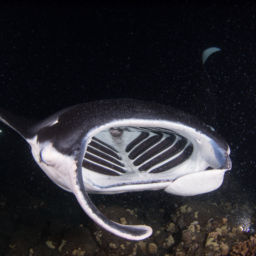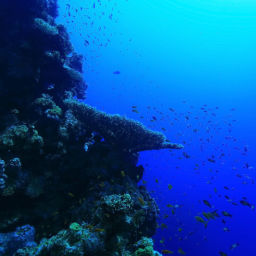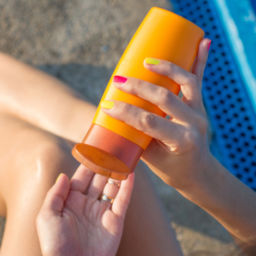Hidden among the sharp lava cliffs on the Big Island of Hawaii’s Kona coastline are lava depressions that fill with seawater each day at high tide. As the tide recedes, the isolated pockets of water become tidepools, miniature worlds containing a bounty of life. These overlooked basins at the ocean’s edge are often only a few feet in diameter with only a few inches of depth. Living in this rugged environment with low oxygen, hours exposed to the sun, and increasing water temperature is certainly not easy for marine life but makes for excellent observation and photography. Here’s a peek at what to expect from Hawaii tidepool marine life.
Viewing lava tidepool life
By carefully leaning into the shallow water at low tide, photographers and lovers of the undersea world can get a glimpse into the delicate and unique ecosystem of Hawaiian tidepools. Though the sharp lava and slippery, algae-covered rock trails can create a challenging approach in some areas, you can view and photograph lava tidepools year-round at low tide by either sitting at the edge of the pool or sliding into the pool with a mask and snorkel, depending on preference and depth. Here’s some of the life you might see.
Variable sargassum (Sargassum Polyphyllum)
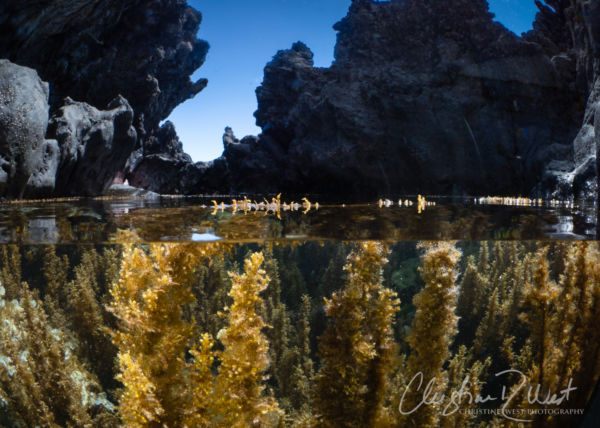 Though the inhabitants of tidepools vary greatly, a common find is some type of brown or green algae. Seeing this variable sargassum from a distance, extending to the surface of the water, is exciting because marine life thrives under and within the wrinkled golden blades and spherical berry-like gas bladders, standing erect in the tidepool like a forest. Fish use this endemic Hawaiian brown algae like coral, for places to hide and to easily camouflage themselves from predators.
Though the inhabitants of tidepools vary greatly, a common find is some type of brown or green algae. Seeing this variable sargassum from a distance, extending to the surface of the water, is exciting because marine life thrives under and within the wrinkled golden blades and spherical berry-like gas bladders, standing erect in the tidepool like a forest. Fish use this endemic Hawaiian brown algae like coral, for places to hide and to easily camouflage themselves from predators.
Marbled shrimp (Saron Marmoratus)
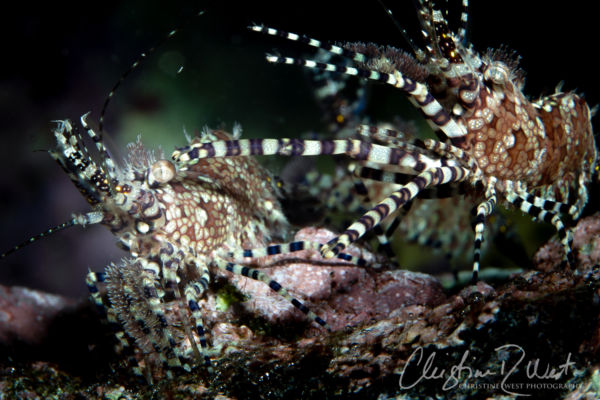 Snorkelers and night divers most frequently see marbled shrimp, but they are exciting finds anytime, with extravagant bands of color and an overall color change from day to night. At night, they seem to take on a reddish hue, but these two are showing the whiter daytime coloration. Males and females have distinctly different characteristics. Males have claw-bearing limbs that are extraordinarily long — longer than their own body length. Females instead have tufts of bristles on their first pair of legs and bodies. These two females were sparring, tucked back in a crevice between two rocks.
Snorkelers and night divers most frequently see marbled shrimp, but they are exciting finds anytime, with extravagant bands of color and an overall color change from day to night. At night, they seem to take on a reddish hue, but these two are showing the whiter daytime coloration. Males and females have distinctly different characteristics. Males have claw-bearing limbs that are extraordinarily long — longer than their own body length. Females instead have tufts of bristles on their first pair of legs and bodies. These two females were sparring, tucked back in a crevice between two rocks.
Zebra blenny (Istiblennius Zebra)
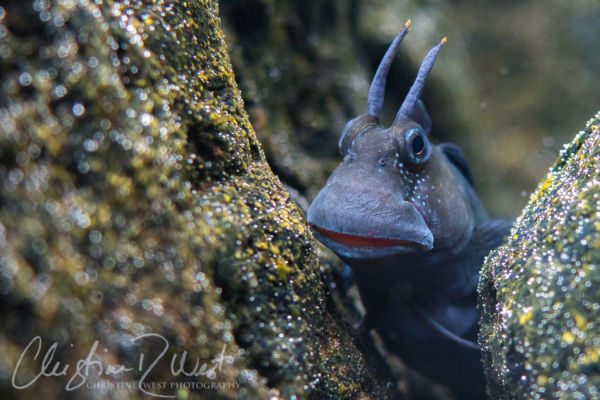 Zebra blennies are one of the more common and obvious endemic dwellers in Hawaiian tidepools. The fish has a variable color pattern, from solid dark gray or blue, to barred or mottled patterns. They routinely zip around the pool freely, stopping to stare at the curious snorkeler, then bounce into a head down orientation, with their massive mouths agape, and feast on detritus covering the sides of the lava rocks. These fish are not confined to one tidepool for life but can wriggle out of the water and leap up to two feet in the air to another tidepool.
Zebra blennies are one of the more common and obvious endemic dwellers in Hawaiian tidepools. The fish has a variable color pattern, from solid dark gray or blue, to barred or mottled patterns. They routinely zip around the pool freely, stopping to stare at the curious snorkeler, then bounce into a head down orientation, with their massive mouths agape, and feast on detritus covering the sides of the lava rocks. These fish are not confined to one tidepool for life but can wriggle out of the water and leap up to two feet in the air to another tidepool.
Flat rock crab (Percnon Planissimum)
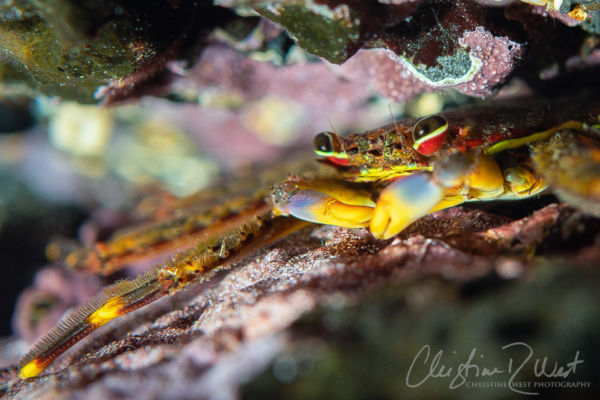 Hidden on the underside of smooth, rounded basalt boulders, you can see brightly colored flat rock crabs during day or night in shallow water. They move quickly and can wedge their flat body into exceedingly small crevices when feeling threatened. A pair of yellow and red walking legs extending from between two rocks may be the only thing a snorkeler sees at first, but with patience, the whole crab may reveal itself.
Hidden on the underside of smooth, rounded basalt boulders, you can see brightly colored flat rock crabs during day or night in shallow water. They move quickly and can wedge their flat body into exceedingly small crevices when feeling threatened. A pair of yellow and red walking legs extending from between two rocks may be the only thing a snorkeler sees at first, but with patience, the whole crab may reveal itself.
Stocky hawkfish (Cirrhitus Pinnulatus)
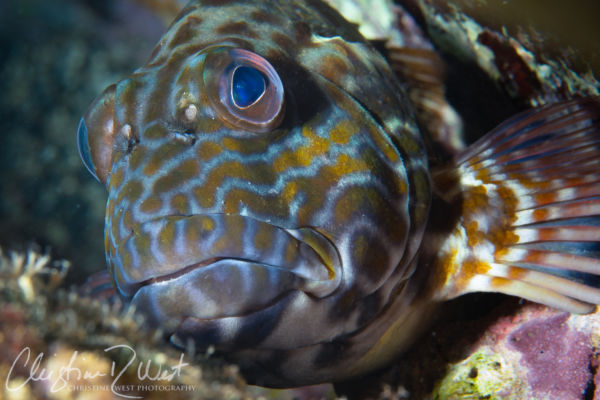 Using the gaps between boulders for protection, the stocky hawkfish occasionally inhabits deeper tide pools, feeding on small invertebrates, snails, and fish. Color patterns can vary, but there are often rich hues of red and aqua present. The stocky hawkfish does not seem to appreciate the company of snorkelers, so approach slowly if you want a close -up view.
Using the gaps between boulders for protection, the stocky hawkfish occasionally inhabits deeper tide pools, feeding on small invertebrates, snails, and fish. Color patterns can vary, but there are often rich hues of red and aqua present. The stocky hawkfish does not seem to appreciate the company of snorkelers, so approach slowly if you want a close -up view.
Glass anemone (Aiptasia Pulchella)
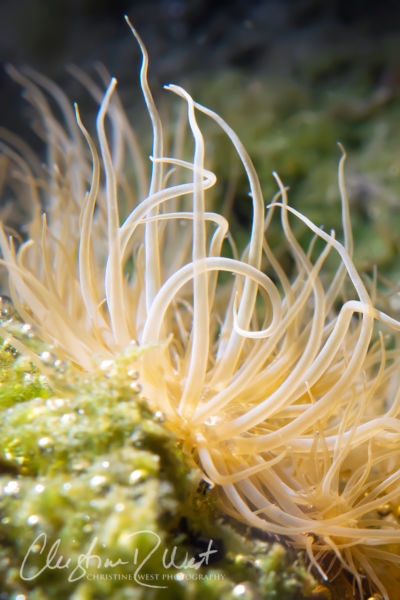 Glass anemones are abundant on walls and in holes with long, translucent brown, yellow or pink tentacles that seem to dance as they extend toward the surface of the tidepool. Understandably, the species name means “beautiful.” These fascinating anemones, made up of hidden communities in dark crevices, can procreate rapidly by detaching bits of tissue from their foot to multiply into baby anemones or give live birth through the mouth.
Glass anemones are abundant on walls and in holes with long, translucent brown, yellow or pink tentacles that seem to dance as they extend toward the surface of the tidepool. Understandably, the species name means “beautiful.” These fascinating anemones, made up of hidden communities in dark crevices, can procreate rapidly by detaching bits of tissue from their foot to multiply into baby anemones or give live birth through the mouth.
Left-handed hermit crab (Calcinus Laevimanus)
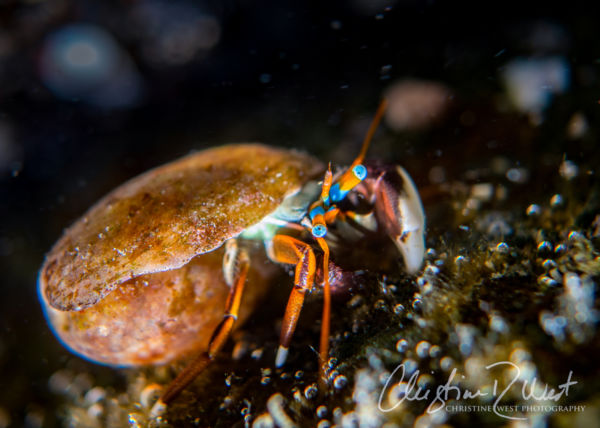 Found foraging in no more than a few inches of water, this tiny crab is one of the more common tidepool hermit crabs in Hawaii. When feeling threatened, the crab fully retreats its soft abdomen and body within the chosen shell, often a snail shell, then locks the door to its house by raising its enormous left claw to seal the shell’s opening. At only ¼-inch long, look closely to find these colorful crabs.
Found foraging in no more than a few inches of water, this tiny crab is one of the more common tidepool hermit crabs in Hawaii. When feeling threatened, the crab fully retreats its soft abdomen and body within the chosen shell, often a snail shell, then locks the door to its house by raising its enormous left claw to seal the shell’s opening. At only ¼-inch long, look closely to find these colorful crabs.
By guest author Christine Regent West
Christine is a naturalist, photographer and videographer, USCG 100-ton Captain and Cressi Ambassador. She seeks to explore and document stories about the extraordinary, places poorly understood, often beneath murky, cold water in places like Alaskan lakes, rivers and fjords. Christine currently dives on expedition ships around the globe for Lindblad-National Geographic Expeditions. Check out more of her work at her website and on Instagram.


